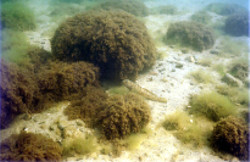Poland

| BAY OF PUCK, SOUTHERN BALTIC |
Poland |
|

|
|
|
|
| Co-ordinates: 54°45'N 18°30'E | The steep shores of Bay at Oslonino, photo S. Andrulewicz |
Description of site:
Bay of Puck is an inner basin of the Bay of Gdansk, one of the few embayments
at the southern coast of Baltic sea. Bay covers an area of approx. 40.000 ha,
its inner part is a shallow, sandy seagrass bed. It is microtidal area, salinity
ranges from 3 to 6 PSU and is typical for the large region of southern Baltic,
Bay is sheltered from direct sea waves and was known as a nursery ground and
breeding area for number of fish and bird species. The bay contains all types
of habitats (from muddy to stony bottom) and variety of shore types (sandy beaches,
gravel beds, stony outcrops, clay cliffs, vegetated river mouths etc) known
from the Baltic. Bay is protected as marine part of Seaside Lanscape Park.
Description of fauna and flora:
The exposed character of southern Baltic sea coast makes rare embayments centres
of local biodiversity. Extensive Zostera marina and Mytilus edulis trossulus
beds are the structuring elements for the diversity of life in the Bay. The
marine fauna and flora has received attention from amateur and professional
collectors and recorders over the past century. Since 1920-ties regular marine
biological research are going on. From the potential pool of some 500 macroscopic
species of Baltic, at least 170 have been noted in the Bay of Puck. Inventories
of many components of the biota have been published: these include phytoplankton,
macroalgae, Ciliata, parasitic Platyhelmintes, free living Nematoda, Oligochaeta,
Polychaeta, Crustacea, Mollusca, Bryozoa, Hydrozoa and fishes. In addition,
there are around 100 other publications relating specifically to the biodiversity
or natural environment of the Bay of Puck. The longest formal time series data
are for zoobenthos (from 1920 to the present).
Human impact:
The Bay is situated at the major harbour city of Gdynia and very popular tourist
resort of central Polish coast. Area is eutrophicated, typically for the whole
large region of Baltic. Atypical stressors are not present within the bay. There
is active artisan net and trap fishing. No dredging or waste disposal is allowed
within the Bay.
On-going research:
The Bay is the major focus for the Polish National Marine Research Programme
for biodiversity. Number of marine scientists from Consortium of Polish Marine
Research Institutes spend a significant proportion of their time on the biodiversity-
related research, in addition there are numerous European scientists also undertaking
marine biological work in the area.
 Facilities:
Facilities:
The extensive appropriate infrastructure is available (laboratory facilities,
microscopes, holding facilities for fresh material). Facilities for collecting
are available (small research boats, zodiacs etc). The services offered in University
of Gdansk Marine Research Station at Hel: Accommodation for up to 20 persons
connected with marine biological programme, modern telecommunications. Other
laboratories and research sites are available in Institute of Oceanology in
Sopot, Sea Fisheries Institute in Gdynia and Institute of Oceanography in Gdynia.
Access year-round, some of the labs are situated at the water front of the Bay.
For SCUBA diving all needed facilities are present including decompression chambers
etc.
Database available:
Records of marine species occurrence are stored in EXCEL at Sea Fishery Institute
in Gdynia and Institute of Ocenography University of Gdansk.
Commitment:
The Consortium of Polish Marine Research Institutes has an agreed science plan
and specifically allocated budget for biodiversity work. Most of the current
marine research and education at University of Gdansk is focused on the Bay.